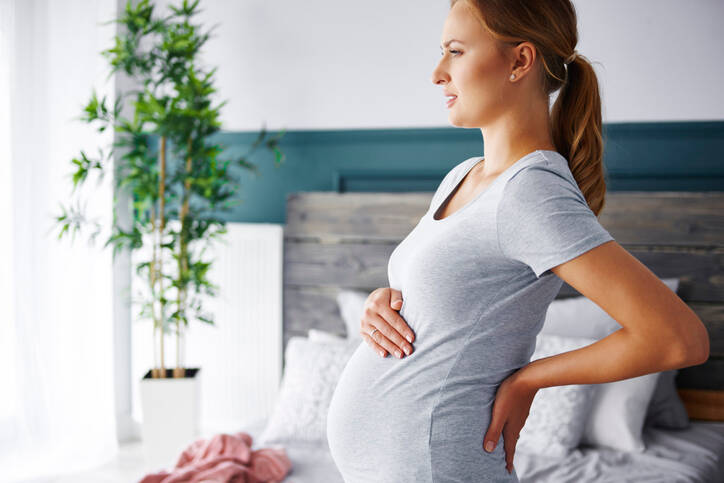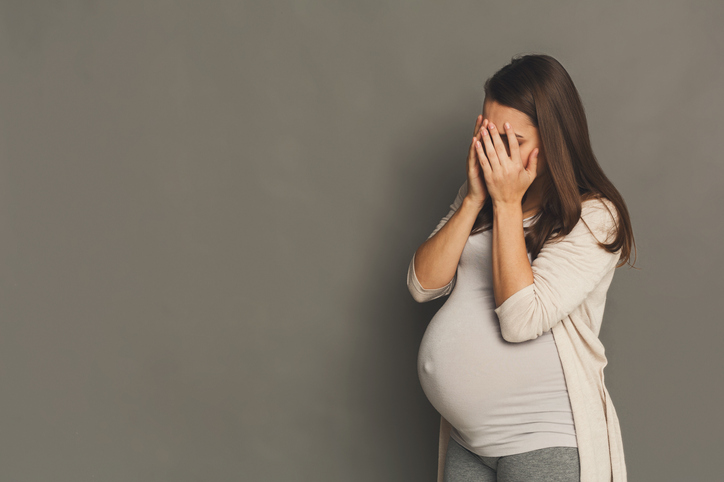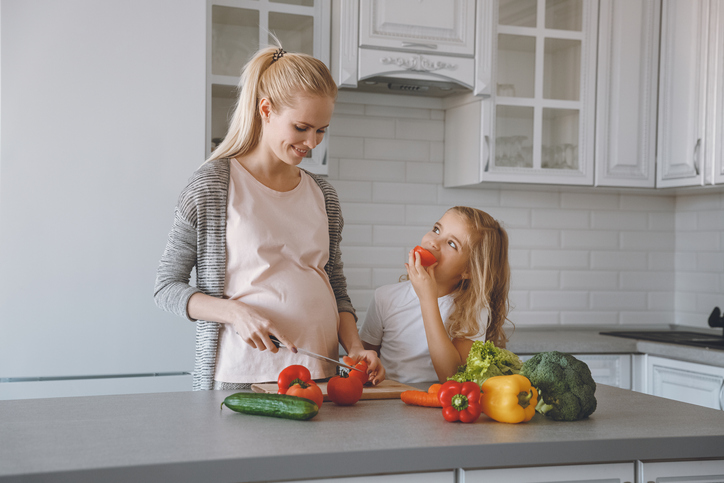In pregnancy, beware of anemia. What causes it, symptoms?

Pregnancy puts a certain strain on the whole organism. The heart and lungs no longer work for just one body. The volume of blood increases, which must also take care of the needs of the unborn child. All this is linked to the risk of anaemia in pregnancy.
Article content
- Why are even perfectly healthy women at risk for anemia in pregnancy?
- Anemia in pregnancy and after childbirth
- Anaemia from folic acid and vitamin B12 deficiency
- Menstruation and anemia
- Symptoms of anemia
- Risks of anaemia in pregnancy
- Treatment of anaemia in pregnancy
- How to avoid anemia in pregnancy
The most common anaemia in general is anaemia caused by a deficiency of the substances necessary for the production of red blood cells. This is mainly a deficiency of iron. This anaemia is called sideropenic and is the most common anaemia even in pregnancy.
According to the World Health Organisation, anaemia in pregnancy is defined as a fall in the haemoglobin concentration below 110 g/l or a fall in the haematocrit value below 0.32.
Read more about the breakdown and types of anaemia in the article.
Variations in pregnancy anaemia have been observed in relation to the period of pregnancy, region and socio-economic conditions. Repeated multiple pregnancies in a shorter period, women with low weight, vegetarian lifestyle, as well as blood donation are also important factors that influence this condition.
During pregnancy, the amount of red blood cells increases. The volume of blood plasma increases more. This condition, where the amount of blood cells is sufficient but low compared to the blood plasma, is referred to as relative anemia.
Why are even perfectly healthy women at risk for anemia in pregnancy?
Pregnancy represents a huge change for a woman's body. The growth of a new life affects every organ or system to some extent. The lungs have to supply much more oxygen, the heart has to pump a higher volume of blood.
The needs of the fetus and placenta lead to the need for an increased supply of iron. This is also needed to ensure increased red blood cell production. Iron is an essential building block.
In many cases, it is not enough to supplement this increased need for iron through the diet. It is easy to become deficient and consequently to have a breakdown in the production of blood cells.
Iron deficiency anaemia (sideropenic anaemia) accounts for 75-95% of cases of anaemia in pregnant women.
Iron deficiency is exacerbated by inadequate iron intake. Inadequate intake is often due to inappropriate dietary composition or lack of other important nutrients in the diet. Socially disadvantaged groups are particularly at risk.
Inadequate iron intake is not due to inadequate food intake but to inadequate food composition.
Anemia in pregnancy and after childbirth
After childbirth, the anaemia that has developed during pregnancy becomes even more pronounced. This is mainly due to blood loss immediately after birth. The so-called haemorrhagic anaemia (anaemia caused by blood loss) is thus added to sideropenic anaemia.
Another factor that contributes to the development of anaemia is the production of breast milk after childbirth. The production of milk (technically lactation) requires sufficient quantities of this building block for its proper functioning.

The initial trigger is a worsening of iron deficiency. Only subsequently does a decrease in hemoglobin, hematocrit and red blood cell count occur.
Anaemia from folic acid and vitamin B12 deficiency
Folic acid deficiency is less common in pregnancy than iron deficiency. Nevertheless, it is not good to underestimate the need for this vitamin. Its absence is most often associated with the risk of developing the so-called neural tube defect. It is a serious condition that threatens the health and the very life of the unborn baby.
You can read more about this disorder and other problems caused by folic acid deficiency in our article.
Types of anaemia in pregnancy
| Iron deficiency anaemia | accounts for 75 to 95% of anaemia in pregnant women |
| Folic acid and vitamin B12 deficiency anaemia | this deficiency is less common, but is already important when planning a pregnancy |
| infectious causes | viral diseases, HIV, cytomegalovirus... |
| anaemia when taking medication | some drugs can cause anaemia |
| unexplained maternal anaemia | anaemia of unknown cause |
Menstruation and anemia
Menstruation is a part of every healthy woman's life. Although it is a natural phenomenon, it is often accompanied by many difficulties and discomforts. It may be a feeling of tiredness, dizziness, pain in the lower abdomen or heavy bleeding.
And it is the heavier bleeding during menstruation that can be a risk factor for the development of anaemia and iron deficiency. Consequently, among other things, there is an increased risk of anaemia in pregnancy or difficulties with pregnancy as such.
If you feel that the course of your menstruation is not natural, contact your doctor. Excessive pain, bleeding or larger blood clots may indicate a more serious disease. These include endometriosis, polyps or cancer.
You may also be interested in the articles Pain during menstruation and Excessive bleeding during menstruation.
Symptoms of anemia
Anemia manifests itself in many non-specific symptoms, such as weakness or fatigue. Significant symptoms only appear in severe anemia. These are mainly lack of appetite, headache, shortness of breath, rapid heartbeat, pale skin and mucous membranes.
During pregnancy, the symptoms are also usually subtle and very non-specific. Feeling tired, sleepiness, headaches, palpitations or difficulty breathing are common accompaniments of pregnancy itself.
The determination of anaemia in pregnancy relies mainly on the medical history and blood count.

The transfer of iron from the mother to the fetus is regulated by the placenta. The most iron for the baby is transferred in the last ten weeks of pregnancy.
Risks of anaemia in pregnancy
Anemia poses risks to the mother, the fetus and the pregnancy itself. The most common risks are reported to be the development of pre-eclampsia, reduced resistance to infection, impaired lactation and breastfeeding, and postpartum depression.
Pregnancy itself is threatened by increased amniotic fluid, miscarriage, premature birth.
The fetus is at risk of developmental disorders, intrauterine developmental delay. The child has low birth weight. It is more susceptible to disease, has poorer postnatal adaptation and impaired psychological and psychomotor development.
In pregnancy, blood counts are usually examined, among other things, which can reveal possible anaemia.
Risk groups prone to anaemia in pregnancy:
- rapid successive pregnancies
- young pregnant women
- women who have heavy menstrual periods
- Vegetarian women
- Vegan women
Treatment of anaemia in pregnancy
A pregnant woman needs an iron supply of approximately 2.5 mg per day. In the last three months of pregnancy (last trimester), the need increases up to 6.6 mg per day.
When anaemia is confirmed in pregnancy, the use of folic acid and iron is recommended. The attending physician will determine the appropriate way to supplement this building block based on the blood count and other anamnestic data or examination.
In pregnancy, the use of many medications is inappropriate or even dangerous. Doctors are very careful in recommending and prescribing them. However, there are cases when there is no other option.
How to avoid anemia in pregnancy
Iron deficiency anaemia can be prevented mainly by a sufficiently balanced and varied diet. The largest source of iron available is meat. Its absorption rate is up to 30%. From other foods, it is usually only about 5% of the iron intake. It is estimated that up to 50% of women do not take the recommended daily dose of iron.

The table below shows the iron content of selected foods
| Food | Iron content in mg per 100 g of food |
| pork liver | 13,0-37,0 |
| beef | 2,0-3,0 |
| pork | 1,0-2,0 |
| chicken meat | 0,43-0,84 |
| chicken eggs | 2,1-2,6 |
| fish | 0,13-1,5 |
| cow's milk | 0,035-0,08 |
| breast milk | 0,03-0,07 |
| Lentils | 6,9-13 |
| beans | 5,9-8,2 |
| soybeans | 5-11 |
| walnuts | 2,1-2,4 |
| husked rice | 0,6-2,3 |
| wheat flour | 1,2-2,5 |
| spinach | 1,0-4,0 |
Aké zmeny čakajú ženu v tehotenstve
Interesting resources
Related










